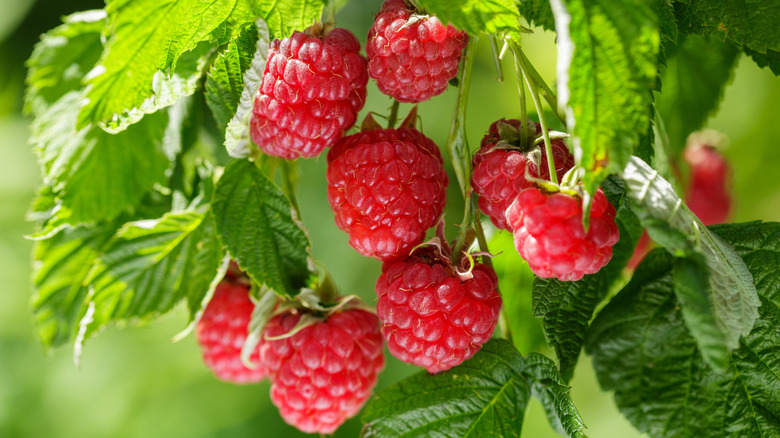What's The Difference Between Primocanes And Floricanes On Raspberries (& Why It Matters)
If you're considering growing raspberries this year, one of the first things you need to understand is the difference between primocanes and floricanes –- no, these aren't fancy cultivars, but rather the stages in the life of a raspberry cane. Primocanes are in the first year of their growth, whereas floricanes are in their second year of growth. You can usually tell the difference between the two by how they look. Knowing the difference can seriously impact how and when you get fruit.
Primocanes show up at the base of your plant and look a vibrant green, while floricanes are taller and have a woody, brown cane. For traditional summer-bearing varieties, you won't see fruit the first year. But with ever-bearing (also called primocane fruiting) cultivars, the tops of these young canes can produce berries in late summer or early fall. Come year two, those primocanes become floricanes and that's when the harvest rolls in. Floricanes push outside branches, called fruiting laterals, and give you your main summer crop. After they fruit, they die off, and the cycle begins again. That's why you'll notice that your raspberry patch has both types of canes. Understanding how the different cane types behave can help you decide the best time of year to plant your raspberries.
How to care for both raspberry cane types
Once you've chosen your raspberry and you've successfully planted it, the maintenance depends entirely on knowing its growth cycle. To put it simply: How to grow and care for a raspberry plant changes based on whether it fruits on primocanes, floricanes, or both. When and how much you prune is essential for future raspberry harvests. Also be aware that red and gold raspberry cultivars tend to spread through underground roots, sending up new primocanes all over the place. If you don't stay on top of them, they'll wander through your whole garden!
For summer-bearing cultivars, which only fruit on floricanes, pruning is pretty simple: Remove all of the second-year canes (the ones that fruited) after harvest. This will encourage the plant's new primocanes to grow strong for the next year's crop. Everbearing raspberries are a little less complicated – just cut all the canes down to the ground in the fall to promote next year's growth. Everbearing raspberries produce all of their fruit on primocanes. Pruning raspberries properly every year will ensure a juicy harvest. And when you're trying to get the best results from your raspberry plant, cane type isn't just a nerdy detail –- it's the key to pruning, timing, and a berry good harvest.
